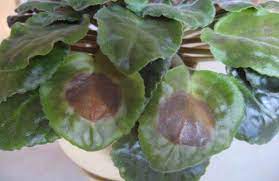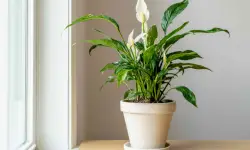Brown spots on African violet leaves can be a cause of concern for plant enthusiasts. These beloved houseplants are known for their vibrant blooms and velvety leaves, so the appearance of unsightly brown spots can be alarming.
Understanding the causes behind these spots is crucial in providing the appropriate care and ensuring the health of your African violets. Several factors can contribute to the development of brown spots, including diseases, pests, environmental conditions, and even natural aging.
In this article, we will explore the various causes of brown spots on African violet leaves and discuss treatment techniques and preventive measures to help you maintain the beauty of your plants.

12 Causes of Brown Spots on African Violet Leaves
African Violet Leaf Scorch
It is a common cause of brown spots on the leaves. This condition occurs when the plant’s leaves are exposed to excessive sunlight or intense heat. The high temperatures lead to leaf dehydration and damage, resulting in brown spots.
To treat African violet leaf scorch, it is essential to provide proper shading and avoid direct sunlight. Placing the plant in a location with bright, indirect light can help prevent scorching. Adequate watering is also crucial to keep the leaves hydrated and prevent further damage.
Preventive measures include placing the African violets away from windows or using sheer curtains to filter sunlight. Regularly monitoring the temperature and adjusting the plant’s placement can prevent leaf scorch.
Rusts on African Violet Leaves
Another culprit behind brown spots on African violet leaves is rust, which are fungal infections that can affect the plant’s foliage. Rusts typically appear as small, reddish-brown spots or pustules on the undersides of the leaves. The spots can merge and cause the leaves to wither and develop brown patches.
It is important to promptly remove and dispose of any affected leaves to prevent the spread of the fungus. Ensure proper air circulation around the plant by avoiding overcrowding and providing adequate space between plants. Applying a fungicide specifically formulated for African violets can help control the infection.
Preventive measures include maintaining good sanitation practices by regularly cleaning the foliage and avoiding overhead watering. Watering at the base of the plant and allowing the leaves to dry completely can help prevent rust infections. Avoid placing African violets in humid environments or near other plants prone to rust diseases.
Powdery Mildew
It is a common fungal disease that can cause brown spots on African violet leaves. It appears as a white, powdery coating on the leaf surface, eventually turning brown and causing the leaves to distort or curl. Powdery mildew thrives in high humidity and poor air circulation conditions.
Remove any infected leaves and dispose of them to prevent the spread of the fungus. Improve air circulation around the plant by providing space between plants and ensuring proper ventilation. Applying a fungicide labeled for powdery mildew control can help eliminate the fungus.
Preventive measures include maintaining moderate humidity levels and avoiding excessive moisture on the leaves. Water the plants at the base and avoid wetting the foliage. Regularly clean the leaves with a soft, damp cloth to remove dust and debris, which can create a favorable environment for powdery mildew growth.
African Violet Bacterial Leaf Blight
Bacterial leaf blight is a bacterial infection that can cause brown spots on African violet leaves. It appears as water-soaked lesions that turn dark brown or black. The spots may have a yellow halo and can enlarge rapidly, causing the leaves to rot and die.
Treating bacterial leaf blight involves removing and discarding any infected leaves. Maintain good sanitation practices by avoiding overhead watering and keeping the leaves dry. Apply a copper-based bactericide, following the instructions on the label for application frequency and dosage.
Watering the plants at the base and avoiding splashing water on the foliage will prevent the issue. Avoid overcrowding plants and provide adequate spacing for air circulation. Regularly monitor your African violets for any signs of disease, and promptly address any issues to prevent the spread of bacterial leaf blight.
African Violet Foliar Nematode
African violet foliar nematodes are microscopic roundworms that can cause brown spots on the leaves. These pests feed on the plant’s tissues, resulting in lesions and brown discoloration. The affected leaves may also become distorted or stunted in growth.
Treating African violet foliar nematodes can be challenging, as they are difficult to eradicate completely. However, removing and destroying the affected leaves can help reduce their population. Discard any heavily infested plants to prevent the spread of nematodes to other healthy plants.
Consider maintaining good sanitation practices, such as keeping the growing area clean and free from debris. Avoid overcrowding plants and ensure proper air circulation. Quarantine new plants before introducing them to your collection to prevent the introduction of nematodes.
Ring Spot
African violet leaf ring spot is a viral disease that can cause brown spots on the leaves. The spots typically appear as concentric rings of brown or dark brown coloration, giving the impression of rings on the leaf surface. The affected areas may also exhibit a wrinkled or distorted appearance.
There is no cure for viral infections in plants. If your African violet is infected with a leaf ring spot, it is best to remove and dispose of the affected leaves. Avoid contact with healthy plants to prevent the spread of the virus.
Preventive measures involve maintaining good sanitation practices, such as disinfecting tools and pots before using them on different plants. Avoid using contaminated soil or planting materials. Additionally, prevent the introduction of pests, as they can transmit viral diseases.
Pest Infestation
Pest infestations can also lead to brown spots on African violet leaves. Common pests that can cause such damage include spider mites, aphids, and thrips. These pests feed on the plant’s tissues, causing discoloration and the formation of brown spots or speckles.
Identify the specific pest and choose the appropriate method of control. Spider mites can be controlled by regularly misting the leaves with water to increase humidity and using insecticidal soap or neem oil. Aphids and thrips can be removed manually or treated with insecticidal soap or horticultural oil.
Preventive measures for pest infestations include regularly inspecting your African violets for signs of pests and taking immediate action if detected. Quarantine new plants before introducing them to your collection to prevent the spread of pests.
Fertilizer Overdose
Overdosing on fertilizers can result in brown spots on African violet leaves. Excessive amounts of fertilizer can cause a buildup of salts in the soil, leading to nutrient imbalances and leaf burn. The burn manifests as brown spots or edges on the leaves.
To treat fertilizer overdose, flush the soil with water to leach out the excess salts. Water the plant thoroughly, allowing water to flow freely through the drainage holes and rinse away the accumulated salts. Adjust your fertilization routine by following the recommended dosage and frequency for African violets. Dilute the fertilizer as instructed to avoid over-concentration.
Follow the instructions on the fertilizer packaging and use the recommended dosage for African violets. Remember that less is often more when it comes to fertilizing these plants. Monitor the condition of your African violets and adjust the fertilization schedule if necessary.
Natural Aging Process
As African violet leaves age, they naturally develop brown spots. This is a normal part of the plant’s life cycle. As older leaves near the end of their lifespan, they may exhibit browning and discoloration. This is particularly common in the lower leaves of the plant.
Treatment for the natural aging process causing brown spots is not necessary. Instead, focus on maintaining overall plant health by providing adequate light, water, and nutrition. Regularly remove older leaves as they deteriorate to maintain a neat and healthy appearance for your African violet.
Appropriate lighting and regular care are crucial. By providing proper care, you can minimize the occurrence of brown spots due to the natural aging process.
Extreme Temperature
Extreme temperatures can have adverse effects on African violets, leading to brown spots on the leaves. Exposure to extreme heat or cold can cause stress to the plants, resulting in leaf damage and discoloration.
Place your African violets away from drafty windows or heating/cooling vents. Maintain a moderate and consistent temperature range suitable for African violets, ideally between 65°F and 75°F (18°C to 24°C). Avoid sudden temperature fluctuations, as they can shock the plants.
Providing a stable and comfortable environment for your African violets is a preventive measure. Protect them from direct exposure to cold drafts or hot air currents. Using insulating materials like blinds or curtains can help regulate temperature fluctuations. Regularly monitor the temperature around your plants and make adjustments as needed.
Poor Air Circulation
Insufficient air circulation around African violets can contribute to the development of brown spots on the leaves. Stagnant air creates a favorable environment for fungal and bacterial diseases, which can cause discoloration and leaf damage.
To improve air circulation, avoid overcrowding plants and provide adequate spacing between them. This allows air to flow freely around the foliage. Positioning a small fan nearby on a low setting can also help improve air movement.
Maintaining an open and well-ventilated growing area for your African violets. Avoid placing them in enclosed spaces or areas with poor air circulation. Regularly clean the area around your plants to remove dust and debris that can impede air movement. Proper air circulation helps prevent the buildup of humidity and reduces the risk of fungal and bacterial infections.
Low Indoor Humidity
Low humidity levels can contribute to the occurrence of brown spots on African violet leaves. Insufficient moisture in the air can lead to dehydration and stress on the plants, resulting in leaf discoloration and the formation of brown spots.
To increase indoor humidity, you can place a tray filled with water near the African violets. As the water evaporates, it raises the humidity in the immediate vicinity. Alternatively, using a humidifier in the room can help maintain a suitable humidity level for your plants.
Preventive measures include regularly monitoring the humidity levels around your African violets and ensuring they are within the ideal range of 40% to 60%. Avoid placing the plants near sources of dry air, such as heating vents or air conditioning units. Misting the leaves occasionally or using a pebble tray filled with water can also help increase humidity.
Final Thoughts
Brown spots on African violet leaves can have various causes, including diseases, pests, environmental conditions, and natural aging. Identifying the specific cause is crucial for implementing appropriate treatment techniques and preventive measures.
Regular monitoring of your African violets, maintaining proper care practices, and addressing issues promptly can help prevent and mitigate the occurrence of brown spots. Providing optimal growing conditions, including suitable lighting, watering, humidity, and temperature, is essential for maintaining the health and beauty of your African violets. (Source: Clemson Cooperative Extension)
People Who Read This Also Read:
- African Violet Leaves Falling Off (Causes & Solutions)
- African Violet Leaves Drooping (Causes & Solutions)
- African Violet Leaves Curling (Causes & Solutions)
- African Violet Leaves Turning Yellow (Causes & Solutions)
- African Violet Leaves Turning Brown (Causes & Solutions)
- How to Care for African Violets Indoors
- African Violet Not Flowering (Causes & Solutions)






